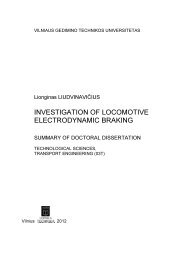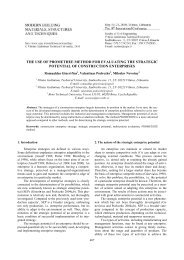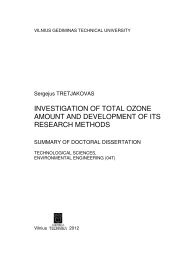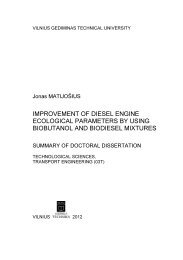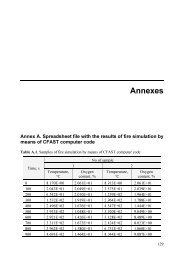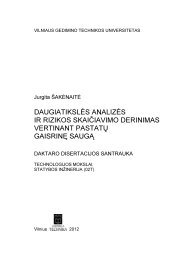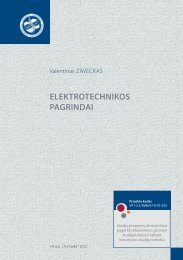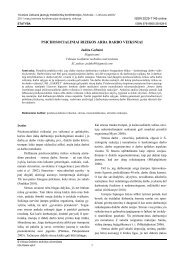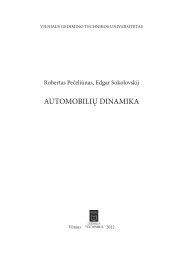ðÑÂрþôøýðüøúð òþ÷ôухþþчøÑÂтýых уÑÂтрþùÑÂтò Ѡ÷õрýøÑÂтыü ÑÂûþõü
ðÑÂрþôøýðüøúð òþ÷ôухþþчøÑÂтýых уÑÂтрþùÑÂтò Ѡ÷õрýøÑÂтыü ÑÂûþõü
ðÑÂрþôøýðüøúð òþ÷ôухþþчøÑÂтýых уÑÂтрþùÑÂтò Ѡ÷õрýøÑÂтыü ÑÂûþõü
Create successful ePaper yourself
Turn your PDF publications into a flip-book with our unique Google optimized e-Paper software.
318 Summary<br />
to 200 Pa. The vitality of microorganisms also depends on aerodynamic resistance.<br />
Where pressure is high, they may die which results in considerably decreased treatment<br />
efficiency of the device. However, as practice shows, microorganisms are<br />
capable of withstanding the pressure of up to 50 atmospheres. Biological air treatment<br />
devices are not likely to be exposed to such aerodynamic pressure. After five<br />
layers of the charge composed of wood chips, barks, natural zeolite granules and<br />
foam cubes, 75 mm high bio-filter aerodynamic resistance at the supplied airflow<br />
rate of 0.1 m/s reached 741 Pa. Upon increasing the rate of the airflow supplied to<br />
the device up to 0.3 m/s after five layers charge’s aerodynamic resistance reaches<br />
1 226 Pa. The carried out investigations show that the aerodynamic resistance of<br />
synthetic-origin charges depends on time. The resistance of the charge composed<br />
of ceramic rings reached 1 500 Pa. Bio-filter aerodynamic resistance of 1 700 Pa/m<br />
was achieved upon using other materials such as a mixture of peat and bark. The<br />
lowest aerodynamic resistance, 200 Pa/m, was obtained using wood chips for biological<br />
treatment.<br />
Chapter 7 Aerodynamic Peculiarities in Devices with a Granulated Charge<br />
Layer discusses devices of different structures used by industries, presents the peculiarities<br />
of devices aimed at reducing the aerodynamic resistance of charging and<br />
analyses technologies for gas distribution in devices with a thin layer of granulated<br />
charge. It presents airflow directions in devices with an equalising partition of gas<br />
flow and in devices with an extended air supply branch pipe which initially diverts<br />
airflow in the flow-reverse direction. Currently, different technologies are being developed<br />
in order to achieve a uniform distribution of gas flow within the entire layer<br />
of granulated charge. In order to achieve the uniform distribution of gas flow within<br />
the entire layer of the charge, device cassettes with granulated charge are shifted<br />
from 0 to 11° angle. Cassette height, length and width can reach 95×600×300 mm<br />
respectively. The directions of gas flow in the charge were identified upon adding<br />
soot particles to gas flow which coloured the respective places of gas flowing. The<br />
preciseness of this method, in terms of quality and quantity, was proved by subsequently<br />
applied thermoanemometers. The chapter presents the directions of gas<br />
flows on the basis of the research methods. The distribution of airflow rate within<br />
the entire width of a cassette was discussed. To achieve the uniform distribution of<br />
airflow, diffusive systems were used in the device and cone-shaped diffusers were<br />
investigated. Subject to the type and length of a diffuser, the ratio of airflow rates<br />
W/W 0<br />
(when W 0<br />
= 2.5 m/s) may vary from 0.7 to 1.4. It is recommended to use<br />
granulated charges composed of silica gel balls of 3–5 mm diameter in cassette filters.<br />
In order to reduce the aerodynamic resistance of charging, attempts are made to<br />
develop the structure of a uniform layer of the cylinder-shaped charge. This chapter<br />
also focuses on the analysis of reactors operating on the catalytic principle of cleaning<br />
the air from gaseous pollutants.



